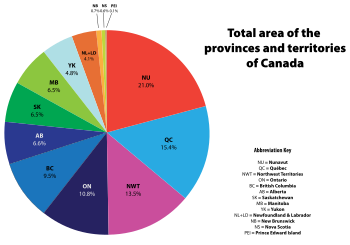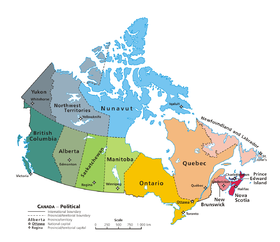List of Canadian provinces and territories by area
As a country, Canada has ten provinces and three territories. These subdivisions vary widely in both land and water area. The largest subdivision by land area is the territory of Nunavut. The largest subdivision by water area is the province of Quebec. The smallest subdivision of both land and water area is the province of Prince Edward Island.[1]

Canada is the second-largest country in the world; it has the fourth-largest dry land area, and the largest freshwater area.[2]
Listings[edit]
Total area[edit]
The total area of a province or territory is the sum of its land area and the area of its internal water (freshwater only).
Areas are rounded to the nearest square kilometre or square mile. Percentages are given to the nearest tenth of a percent.
| Rank | Name | Total area (km2)[1] | Total area (mi2)[1] | Percentage of national total area[1] |
|---|---|---|---|---|
| 1 | 2,093,190 | 808,185 | 21.0% | |
| 2 | 1,542,056 | 595,391 | 15.4% | |
| 3 | 1,346,106 | 519,734 | 13.5% | |
| 4 | 1,076,395 | 415,598 | 10.8% | |
| 5 | 944,735 | 364,764 | 9.5% | |
| 6 | 661,848 | 255,541 | 6.6% | |
| 7 | 651,036 | 251,366 | 6.5% | |
| 8 | 647,797 | 250,116 | 6.5% | |
| 9 | 482,443 | 186,272 | 4.8% | |
| 10 | 405,212 | 156,453 | 4.1% | |
| 11 | 72,908 | 28,150 | 0.7% | |
| 12 | 55,284 | 21,345 | 0.6% | |
| 13 | 5,660 | 2,185 | 0.1% | |
| Total | 9,984,670 | 3,855,103 | 100.0% |
Land area[edit]
Land areas consist of dry land, excluding areas of freshwater, and or salt water.
Areas are rounded to the nearest whole unit. Percentages are given to the nearest tenth of a percent.
| Rank | Name and flag | Land area (km2)[1] | Land area (mi2)[1] | Percentage of national land area |
|---|---|---|---|---|
| 1 | 1,936,113 | 747,537 | 21.3% | |
| 2 | 1,365,128 | 527,079 | 15.0% | |
| 3 | 1,183,085 | 456,792 | 13.0% | |
| 4 | 925,186 | 357,216 | 10.4% | |
| 5 | 917,741 | 354,342 | 10.1% | |
| 6 | 642,317 | 248,000 | 7.1% | |
| 7 | 591,670 | 228,445 | 6.5% | |
| 8 | 553,556 | 213,729 | 6.1% | |
| 9 | 474,391 | 183,163 | 5.2% | |
| 10 | 373,872 | 144,353 | 4.1% | |
| 11 | 71,450 | 27,587 | 0.8% | |
| 12 | 53,338 | 20,594 | 0.6% | |
| 13 | 5,660 | 2,185 | 0.1% | |
| Total | 9,093,507 | 3,511,023 | 100.0% |
Internal water area (fresh-water only)[edit]
The internal water area data below, includes freshwater (i.e., lakes, rivers, reservoirs, and canals). It excludes internal salt water and territorial waters claimed by Canada in the Atlantic, Pacific, and Arctic Oceans. Canada considers its internal water area to include 1,600,000 km2 of salt water in Hudson Bay and the ocean within and around Canada's Arctic Archipelago. Canada's territorial sea is 200,000 km2.[3][4][5]
Areas are given to the nearest whole unit. Percentages are given to the nearest tenth of a percent.
| Rank | Name and flag | Water area (km2)[1] | Water area (mi2)[1] | Water area as percentage of total area |
Percentage of national freshwater area |
|---|---|---|---|---|---|
| 1 | 176,928 | 68,312 | 11.5% | 19.9% | |
| 2 | 163,021 | 62,943 | 12.1% | 18.3% | |
| 3 | 158,654 | 61,257 | 14.7% | 17.8% | |
| 4 | 157,077 | 60,648 | 7.5% | 17.6% | |
| 5 | 94,241 | 36,387 | 14.5% | 10.6% | |
| 6 | 59,366 | 22,921 | 9.1% | 6.7% | |
| 7 | 31,340 | 12,100 | 7.7% | 3.5% | |
| 8 | 19,549 | 7,548 | 2.1% | 2.2% | |
| 9 | 19,531 | 7,541 | 3.0% | 2.2% | |
| 10 | 8,052 | 3,109 | 1.7% | 0.9% | |
| 11 | 1,946 | 751 | 3.5% | 0.2% | |
| 12 | 1,458 | 563 | 2.0% | 0.2% | |
| 13 | 0 | 0 | 0.0% | 0.0% | |
| Total | 891,163 | 344,080 | 8.9% | 100.0% |
See also[edit]
Other articles of the topic Canada : Canadian hip hop
Some use of "" in your query was not closed by a matching "".Some use of "" in your query was not closed by a matching "".
- Demographics of Canada
- List of political and geographic subdivisions by total area
- Population of Canada by province and territory
References[edit]
- ↑ 1.0 1.1 1.2 1.3 1.4 1.5 1.6 1.7 "Land and freshwater area, by province and territory". Statistics Canada. 2005-02-01. Archived from the original on 2011-05-24. Retrieved 2009-11-30. Unknown parameter
|url-status=ignored (help) - ↑ Field Listing:: Area. CIA World Factbook. Central Intelligence Agency. Retrieved 2009-11-30. Search this book on

- ↑ "The Arctic: Canada's Legal Claims". www.lop.parl.gc.ca. Archived from the original on 2016-03-06. Retrieved 2016-03-04. Unknown parameter
|url-status=ignored (help) - ↑ Canada, Government of Canada, Statistics. "Land and freshwater area, by province and territory". www.statcan.gc.ca. Retrieved 2016-03-04.
- ↑ Branch, Government of Canada, Fisheries and Oceans Canada, Communications. "Oceans". www.dfo-mpo.gc.ca. Retrieved 2016-03-04.
Further reading[edit]
- Moore, Christopher; Slavin, Bill; Janet Lunn (2002), The Big Book of Canada: Exploring the Provinces and Territories, Tundra Books, ISBN 0-88776-457-6
This article "List of Canadian provinces and territories by area" is from Wikipedia. The list of its authors can be seen in its historical and/or the page Edithistory:List of Canadian provinces and territories by area. Articles copied from Draft Namespace on Wikipedia could be seen on the Draft Namespace of Wikipedia and not main one.

